Alcoholism in Primary Healthcare: Policies, Research, and Barriers
VerifiedAdded on 2022/12/30
|9
|2082
|76
Report
AI Summary
This report focuses on the cohort group of alcoholism within the context of primary healthcare, addressing the reasons for their special consideration, current health and social care policies, and research findings on primary care delivery. The report highlights the significant impact of alcoholism as a major health concern leading to premature death and its ranking as a leading risk factor for premature death. It explores the policies adopted by Australia to reduce alcohol consumption and subsequent harm, including drink-driving counter measures, restricted alcohol availability, and low-risk drinking guidelines. Furthermore, the report reviews the effectiveness of primary care in facilitating successful abstinence from drinking, highlighting the importance of connecting with patients, providing lifestyle advice, and offering access to addiction medicine specialists. The report also discusses the barriers and gaps in receiving primary care delivery, such as understanding the principles of primary health and the perception of healthcare workers regarding substance abuse. It then explores the idea of effective primary care delivery with respect to the Australian Framework and Policy, emphasizing the role of primary care providers in educating patients, assessing addiction levels, and developing strategies for reducing alcohol consumption. The report concludes by outlining strategies to reduce alcohol intake, manage cravings, and the role of medications, counseling, and support groups in addiction recovery.
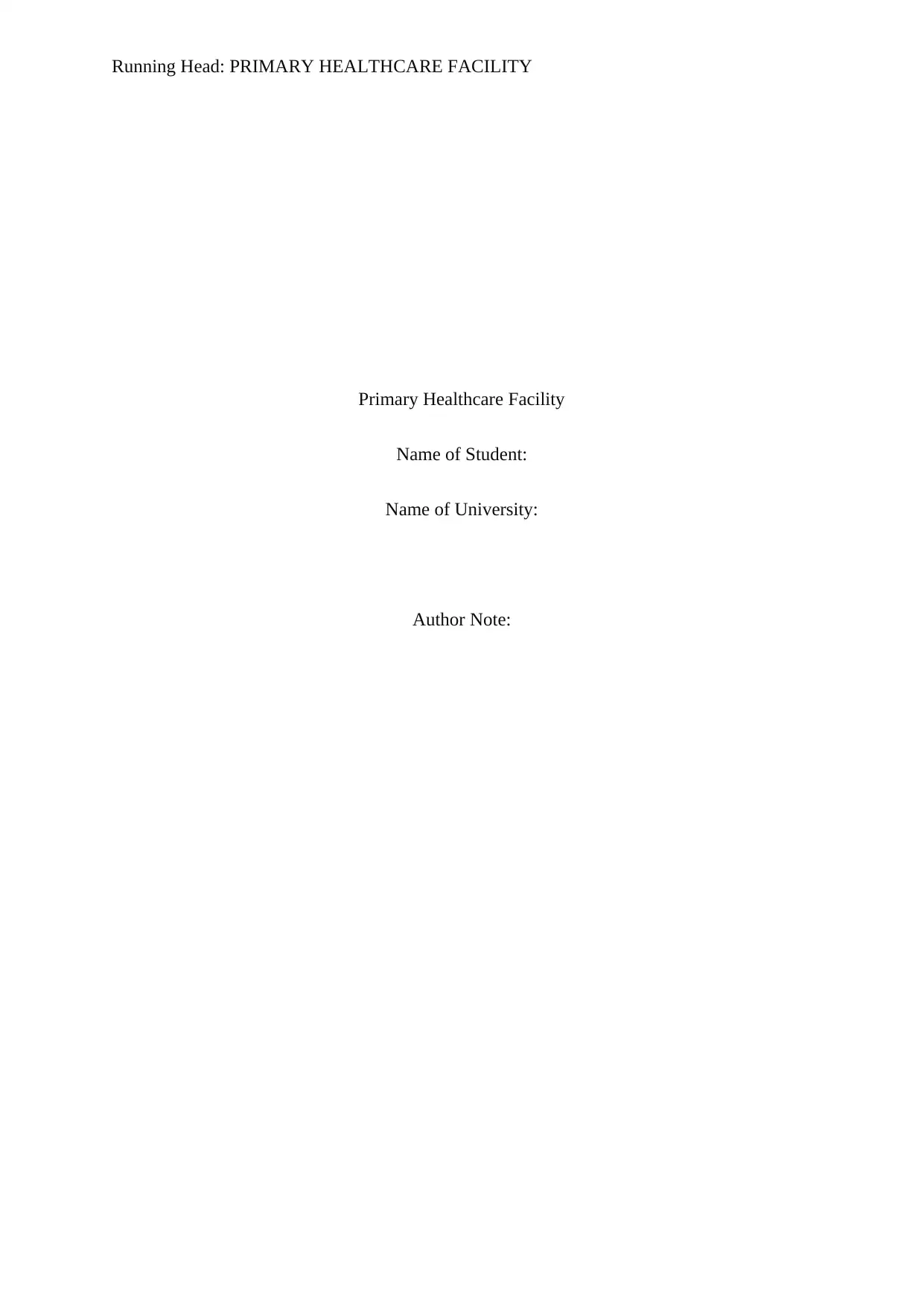
Running Head: PRIMARY HEALTHCARE FACILITY
Primary Healthcare Facility
Name of Student:
Name of University:
Author Note:
Primary Healthcare Facility
Name of Student:
Name of University:
Author Note:
Paraphrase This Document
Need a fresh take? Get an instant paraphrase of this document with our AI Paraphraser
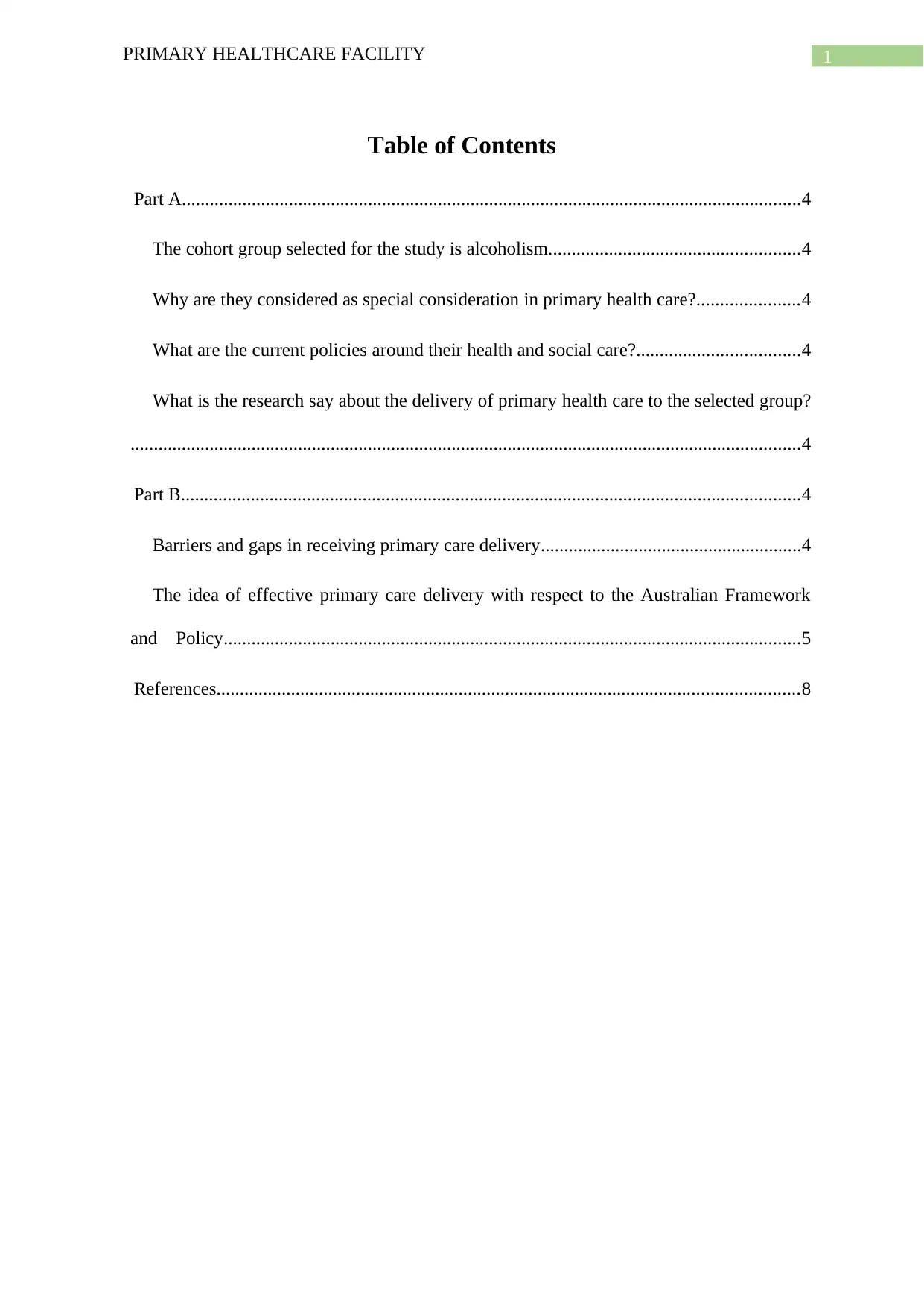
1PRIMARY HEALTHCARE FACILITY
Table of Contents
Part A.....................................................................................................................................4
The cohort group selected for the study is alcoholism......................................................4
Why are they considered as special consideration in primary health care?......................4
What are the current policies around their health and social care?...................................4
What is the research say about the delivery of primary health care to the selected group?
................................................................................................................................................4
Part B.....................................................................................................................................4
Barriers and gaps in receiving primary care delivery........................................................4
The idea of effective primary care delivery with respect to the Australian Framework
and Policy............................................................................................................................5
References.............................................................................................................................8
Table of Contents
Part A.....................................................................................................................................4
The cohort group selected for the study is alcoholism......................................................4
Why are they considered as special consideration in primary health care?......................4
What are the current policies around their health and social care?...................................4
What is the research say about the delivery of primary health care to the selected group?
................................................................................................................................................4
Part B.....................................................................................................................................4
Barriers and gaps in receiving primary care delivery........................................................4
The idea of effective primary care delivery with respect to the Australian Framework
and Policy............................................................................................................................5
References.............................................................................................................................8
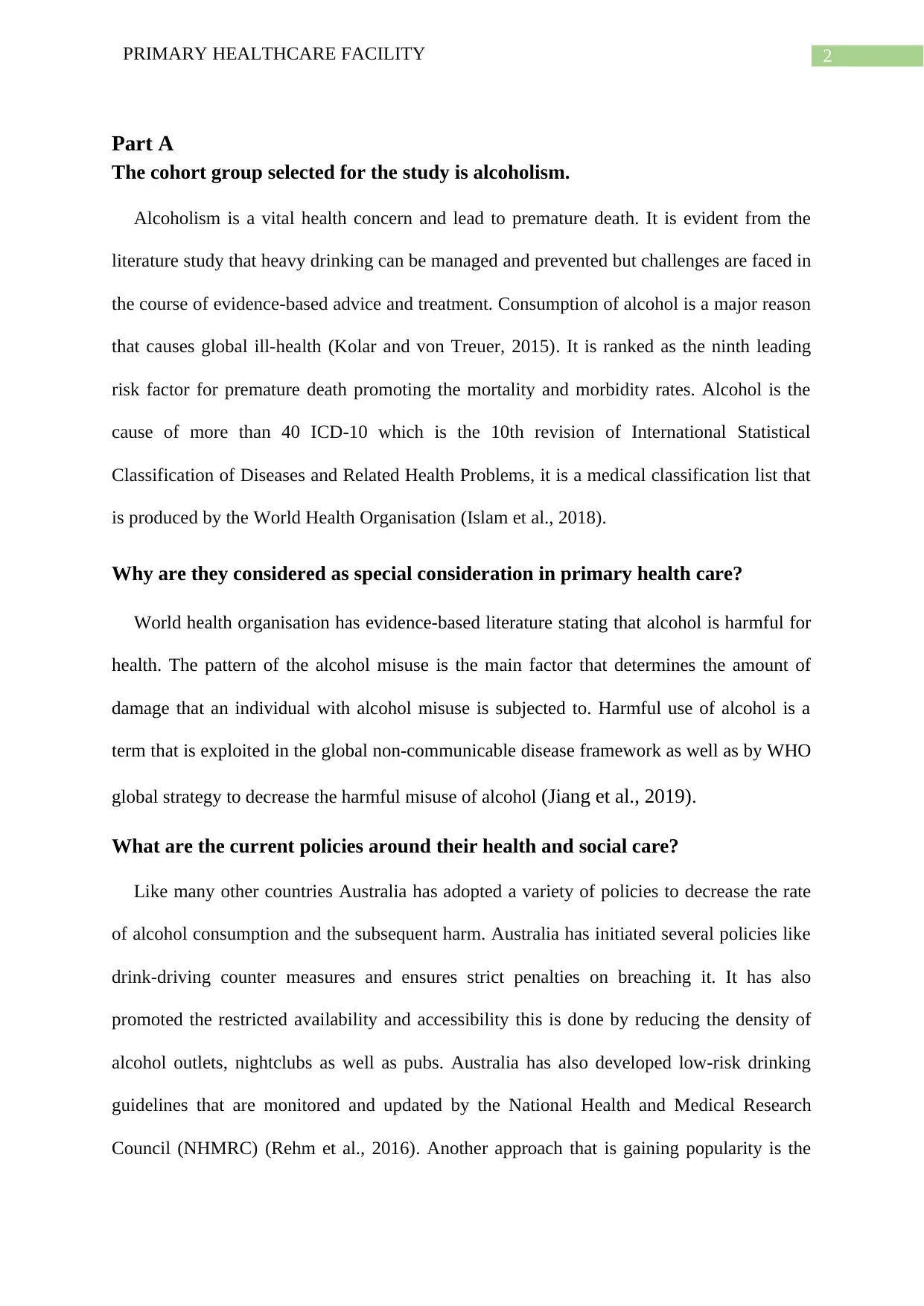
2PRIMARY HEALTHCARE FACILITY
Part A
The cohort group selected for the study is alcoholism.
Alcoholism is a vital health concern and lead to premature death. It is evident from the
literature study that heavy drinking can be managed and prevented but challenges are faced in
the course of evidence-based advice and treatment. Consumption of alcohol is a major reason
that causes global ill-health (Kolar and von Treuer, 2015). It is ranked as the ninth leading
risk factor for premature death promoting the mortality and morbidity rates. Alcohol is the
cause of more than 40 ICD-10 which is the 10th revision of International Statistical
Classification of Diseases and Related Health Problems, it is a medical classification list that
is produced by the World Health Organisation (Islam et al., 2018).
Why are they considered as special consideration in primary health care?
World health organisation has evidence-based literature stating that alcohol is harmful for
health. The pattern of the alcohol misuse is the main factor that determines the amount of
damage that an individual with alcohol misuse is subjected to. Harmful use of alcohol is a
term that is exploited in the global non-communicable disease framework as well as by WHO
global strategy to decrease the harmful misuse of alcohol (Jiang et al., 2019).
What are the current policies around their health and social care?
Like many other countries Australia has adopted a variety of policies to decrease the rate
of alcohol consumption and the subsequent harm. Australia has initiated several policies like
drink-driving counter measures and ensures strict penalties on breaching it. It has also
promoted the restricted availability and accessibility this is done by reducing the density of
alcohol outlets, nightclubs as well as pubs. Australia has also developed low-risk drinking
guidelines that are monitored and updated by the National Health and Medical Research
Council (NHMRC) (Rehm et al., 2016). Another approach that is gaining popularity is the
Part A
The cohort group selected for the study is alcoholism.
Alcoholism is a vital health concern and lead to premature death. It is evident from the
literature study that heavy drinking can be managed and prevented but challenges are faced in
the course of evidence-based advice and treatment. Consumption of alcohol is a major reason
that causes global ill-health (Kolar and von Treuer, 2015). It is ranked as the ninth leading
risk factor for premature death promoting the mortality and morbidity rates. Alcohol is the
cause of more than 40 ICD-10 which is the 10th revision of International Statistical
Classification of Diseases and Related Health Problems, it is a medical classification list that
is produced by the World Health Organisation (Islam et al., 2018).
Why are they considered as special consideration in primary health care?
World health organisation has evidence-based literature stating that alcohol is harmful for
health. The pattern of the alcohol misuse is the main factor that determines the amount of
damage that an individual with alcohol misuse is subjected to. Harmful use of alcohol is a
term that is exploited in the global non-communicable disease framework as well as by WHO
global strategy to decrease the harmful misuse of alcohol (Jiang et al., 2019).
What are the current policies around their health and social care?
Like many other countries Australia has adopted a variety of policies to decrease the rate
of alcohol consumption and the subsequent harm. Australia has initiated several policies like
drink-driving counter measures and ensures strict penalties on breaching it. It has also
promoted the restricted availability and accessibility this is done by reducing the density of
alcohol outlets, nightclubs as well as pubs. Australia has also developed low-risk drinking
guidelines that are monitored and updated by the National Health and Medical Research
Council (NHMRC) (Rehm et al., 2016). Another approach that is gaining popularity is the
⊘ This is a preview!⊘
Do you want full access?
Subscribe today to unlock all pages.

Trusted by 1+ million students worldwide
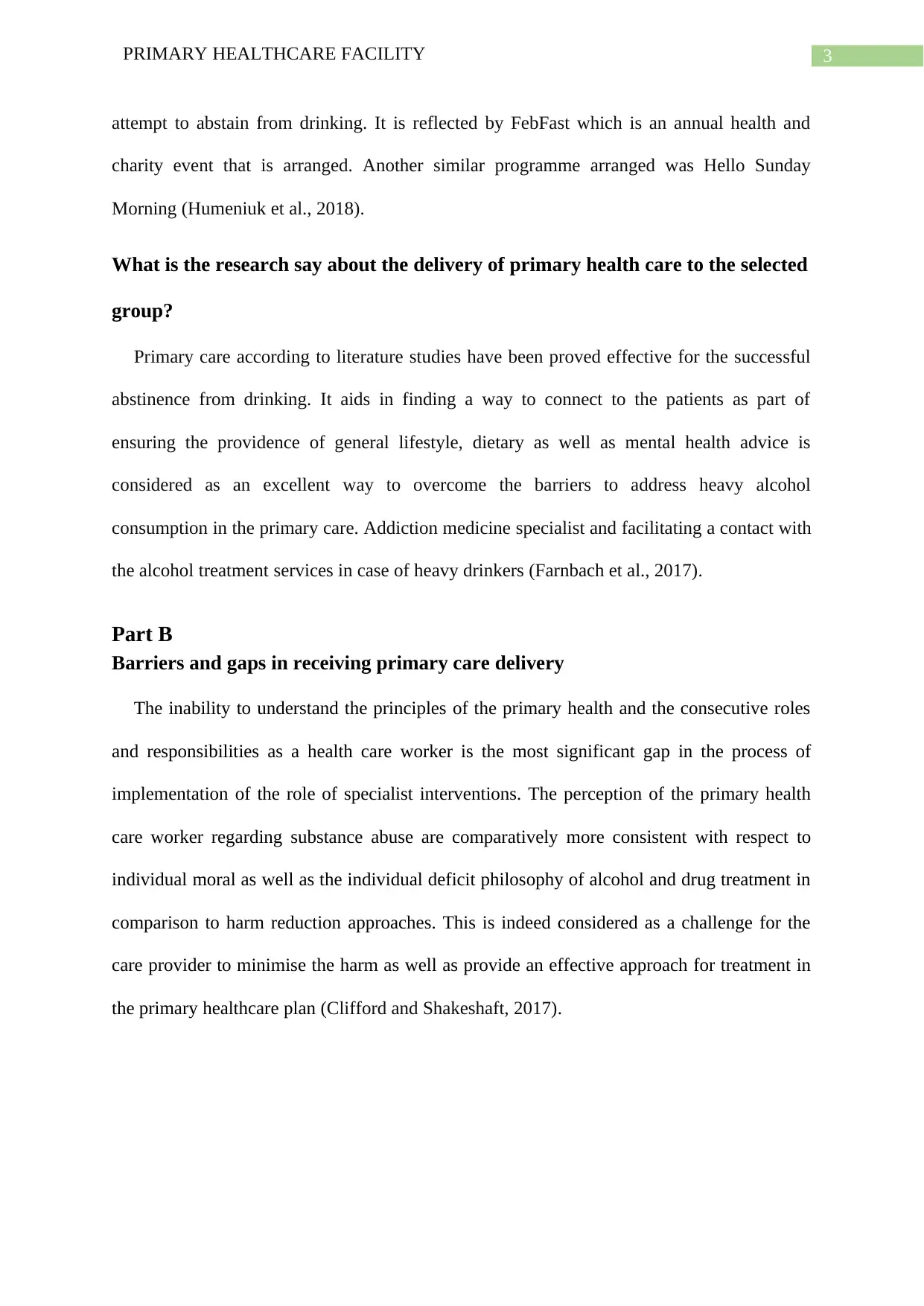
3PRIMARY HEALTHCARE FACILITY
attempt to abstain from drinking. It is reflected by FebFast which is an annual health and
charity event that is arranged. Another similar programme arranged was Hello Sunday
Morning (Humeniuk et al., 2018).
What is the research say about the delivery of primary health care to the selected
group?
Primary care according to literature studies have been proved effective for the successful
abstinence from drinking. It aids in finding a way to connect to the patients as part of
ensuring the providence of general lifestyle, dietary as well as mental health advice is
considered as an excellent way to overcome the barriers to address heavy alcohol
consumption in the primary care. Addiction medicine specialist and facilitating a contact with
the alcohol treatment services in case of heavy drinkers (Farnbach et al., 2017).
Part B
Barriers and gaps in receiving primary care delivery
The inability to understand the principles of the primary health and the consecutive roles
and responsibilities as a health care worker is the most significant gap in the process of
implementation of the role of specialist interventions. The perception of the primary health
care worker regarding substance abuse are comparatively more consistent with respect to
individual moral as well as the individual deficit philosophy of alcohol and drug treatment in
comparison to harm reduction approaches. This is indeed considered as a challenge for the
care provider to minimise the harm as well as provide an effective approach for treatment in
the primary healthcare plan (Clifford and Shakeshaft, 2017).
attempt to abstain from drinking. It is reflected by FebFast which is an annual health and
charity event that is arranged. Another similar programme arranged was Hello Sunday
Morning (Humeniuk et al., 2018).
What is the research say about the delivery of primary health care to the selected
group?
Primary care according to literature studies have been proved effective for the successful
abstinence from drinking. It aids in finding a way to connect to the patients as part of
ensuring the providence of general lifestyle, dietary as well as mental health advice is
considered as an excellent way to overcome the barriers to address heavy alcohol
consumption in the primary care. Addiction medicine specialist and facilitating a contact with
the alcohol treatment services in case of heavy drinkers (Farnbach et al., 2017).
Part B
Barriers and gaps in receiving primary care delivery
The inability to understand the principles of the primary health and the consecutive roles
and responsibilities as a health care worker is the most significant gap in the process of
implementation of the role of specialist interventions. The perception of the primary health
care worker regarding substance abuse are comparatively more consistent with respect to
individual moral as well as the individual deficit philosophy of alcohol and drug treatment in
comparison to harm reduction approaches. This is indeed considered as a challenge for the
care provider to minimise the harm as well as provide an effective approach for treatment in
the primary healthcare plan (Clifford and Shakeshaft, 2017).
Paraphrase This Document
Need a fresh take? Get an instant paraphrase of this document with our AI Paraphraser
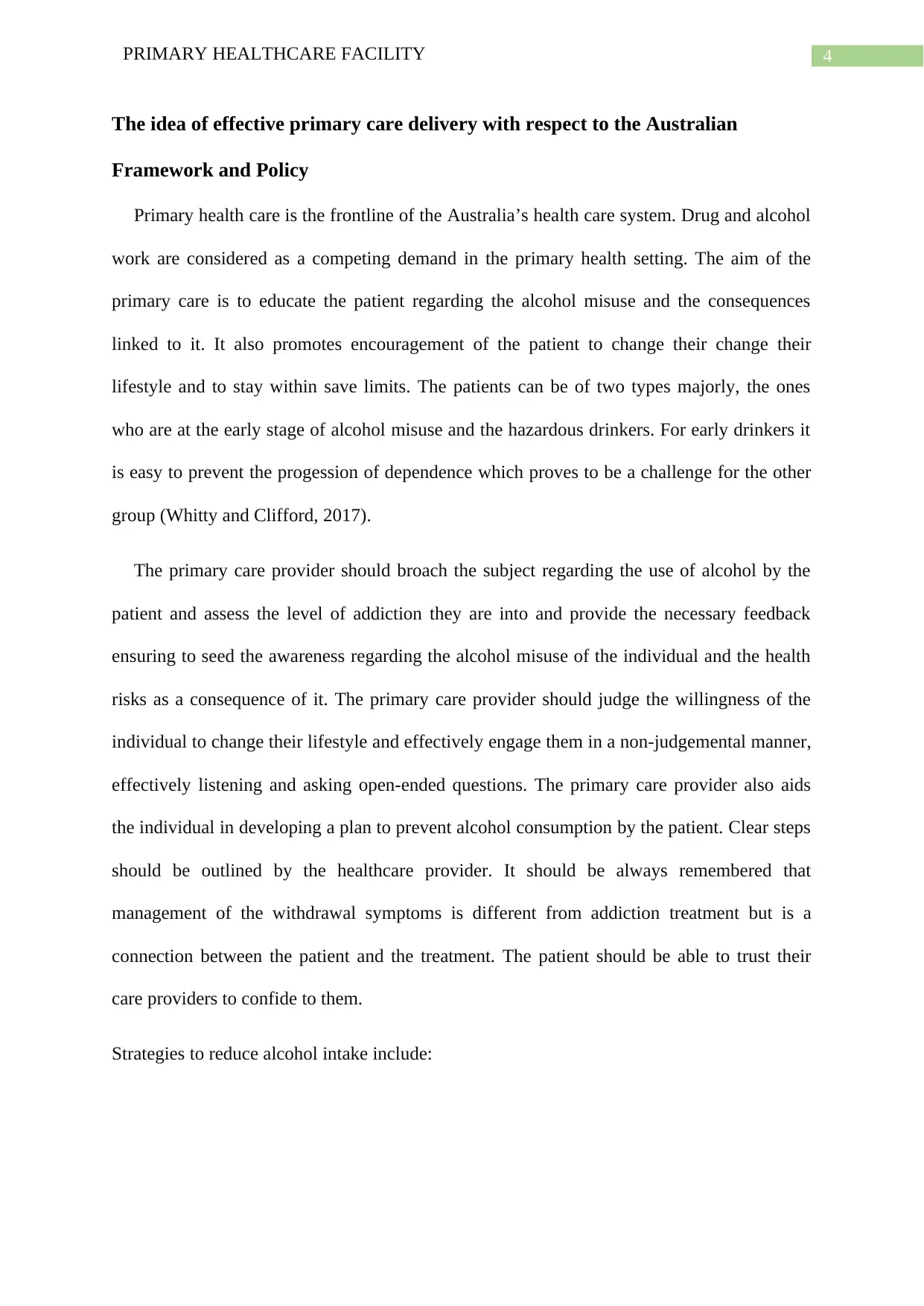
4PRIMARY HEALTHCARE FACILITY
The idea of effective primary care delivery with respect to the Australian
Framework and Policy
Primary health care is the frontline of the Australia’s health care system. Drug and alcohol
work are considered as a competing demand in the primary health setting. The aim of the
primary care is to educate the patient regarding the alcohol misuse and the consequences
linked to it. It also promotes encouragement of the patient to change their change their
lifestyle and to stay within save limits. The patients can be of two types majorly, the ones
who are at the early stage of alcohol misuse and the hazardous drinkers. For early drinkers it
is easy to prevent the progession of dependence which proves to be a challenge for the other
group (Whitty and Clifford, 2017).
The primary care provider should broach the subject regarding the use of alcohol by the
patient and assess the level of addiction they are into and provide the necessary feedback
ensuring to seed the awareness regarding the alcohol misuse of the individual and the health
risks as a consequence of it. The primary care provider should judge the willingness of the
individual to change their lifestyle and effectively engage them in a non-judgemental manner,
effectively listening and asking open-ended questions. The primary care provider also aids
the individual in developing a plan to prevent alcohol consumption by the patient. Clear steps
should be outlined by the healthcare provider. It should be always remembered that
management of the withdrawal symptoms is different from addiction treatment but is a
connection between the patient and the treatment. The patient should be able to trust their
care providers to confide to them.
Strategies to reduce alcohol intake include:
The idea of effective primary care delivery with respect to the Australian
Framework and Policy
Primary health care is the frontline of the Australia’s health care system. Drug and alcohol
work are considered as a competing demand in the primary health setting. The aim of the
primary care is to educate the patient regarding the alcohol misuse and the consequences
linked to it. It also promotes encouragement of the patient to change their change their
lifestyle and to stay within save limits. The patients can be of two types majorly, the ones
who are at the early stage of alcohol misuse and the hazardous drinkers. For early drinkers it
is easy to prevent the progession of dependence which proves to be a challenge for the other
group (Whitty and Clifford, 2017).
The primary care provider should broach the subject regarding the use of alcohol by the
patient and assess the level of addiction they are into and provide the necessary feedback
ensuring to seed the awareness regarding the alcohol misuse of the individual and the health
risks as a consequence of it. The primary care provider should judge the willingness of the
individual to change their lifestyle and effectively engage them in a non-judgemental manner,
effectively listening and asking open-ended questions. The primary care provider also aids
the individual in developing a plan to prevent alcohol consumption by the patient. Clear steps
should be outlined by the healthcare provider. It should be always remembered that
management of the withdrawal symptoms is different from addiction treatment but is a
connection between the patient and the treatment. The patient should be able to trust their
care providers to confide to them.
Strategies to reduce alcohol intake include:
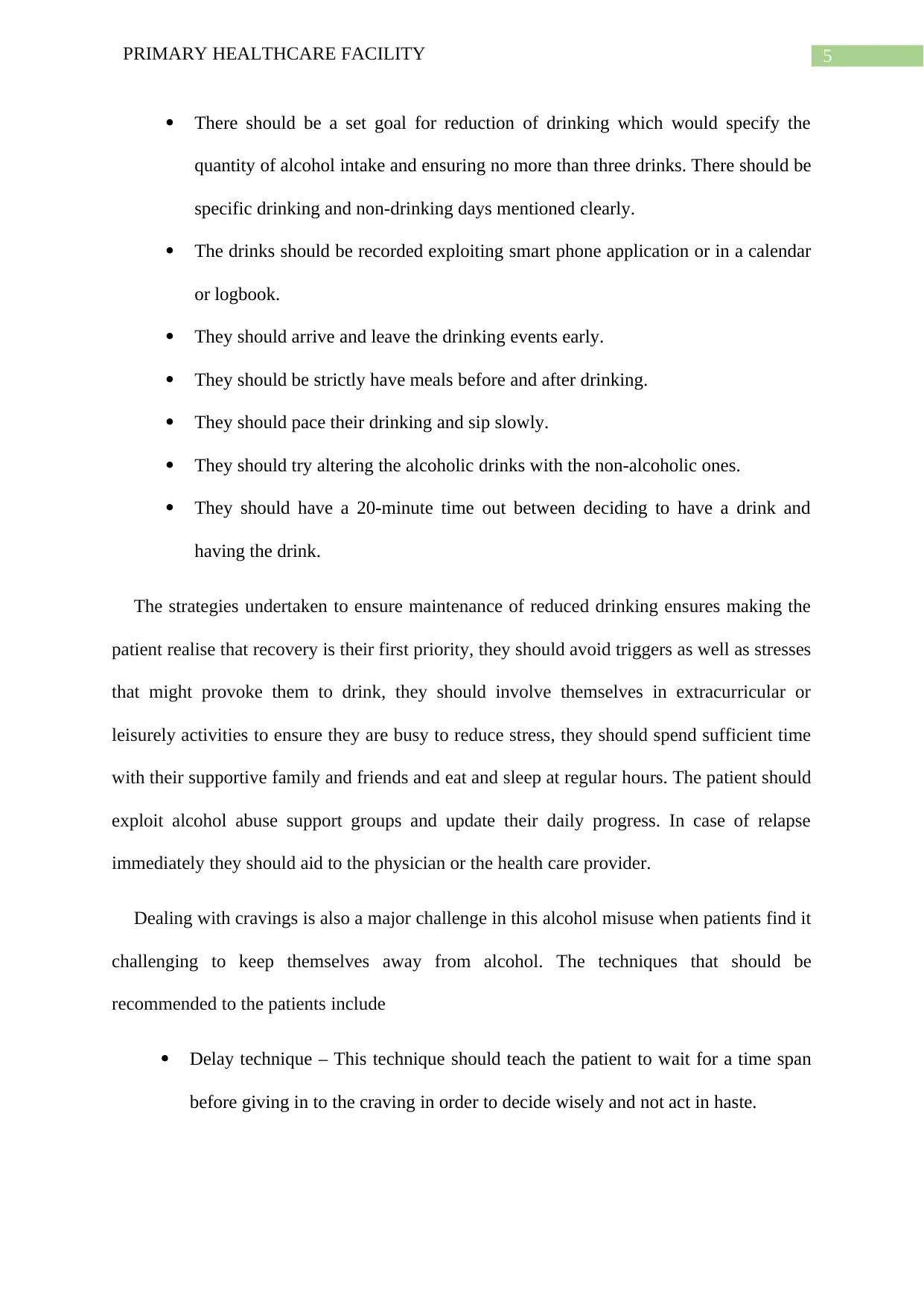
5PRIMARY HEALTHCARE FACILITY
There should be a set goal for reduction of drinking which would specify the
quantity of alcohol intake and ensuring no more than three drinks. There should be
specific drinking and non-drinking days mentioned clearly.
The drinks should be recorded exploiting smart phone application or in a calendar
or logbook.
They should arrive and leave the drinking events early.
They should be strictly have meals before and after drinking.
They should pace their drinking and sip slowly.
They should try altering the alcoholic drinks with the non-alcoholic ones.
They should have a 20-minute time out between deciding to have a drink and
having the drink.
The strategies undertaken to ensure maintenance of reduced drinking ensures making the
patient realise that recovery is their first priority, they should avoid triggers as well as stresses
that might provoke them to drink, they should involve themselves in extracurricular or
leisurely activities to ensure they are busy to reduce stress, they should spend sufficient time
with their supportive family and friends and eat and sleep at regular hours. The patient should
exploit alcohol abuse support groups and update their daily progress. In case of relapse
immediately they should aid to the physician or the health care provider.
Dealing with cravings is also a major challenge in this alcohol misuse when patients find it
challenging to keep themselves away from alcohol. The techniques that should be
recommended to the patients include
Delay technique – This technique should teach the patient to wait for a time span
before giving in to the craving in order to decide wisely and not act in haste.
There should be a set goal for reduction of drinking which would specify the
quantity of alcohol intake and ensuring no more than three drinks. There should be
specific drinking and non-drinking days mentioned clearly.
The drinks should be recorded exploiting smart phone application or in a calendar
or logbook.
They should arrive and leave the drinking events early.
They should be strictly have meals before and after drinking.
They should pace their drinking and sip slowly.
They should try altering the alcoholic drinks with the non-alcoholic ones.
They should have a 20-minute time out between deciding to have a drink and
having the drink.
The strategies undertaken to ensure maintenance of reduced drinking ensures making the
patient realise that recovery is their first priority, they should avoid triggers as well as stresses
that might provoke them to drink, they should involve themselves in extracurricular or
leisurely activities to ensure they are busy to reduce stress, they should spend sufficient time
with their supportive family and friends and eat and sleep at regular hours. The patient should
exploit alcohol abuse support groups and update their daily progress. In case of relapse
immediately they should aid to the physician or the health care provider.
Dealing with cravings is also a major challenge in this alcohol misuse when patients find it
challenging to keep themselves away from alcohol. The techniques that should be
recommended to the patients include
Delay technique – This technique should teach the patient to wait for a time span
before giving in to the craving in order to decide wisely and not act in haste.
⊘ This is a preview!⊘
Do you want full access?
Subscribe today to unlock all pages.

Trusted by 1+ million students worldwide
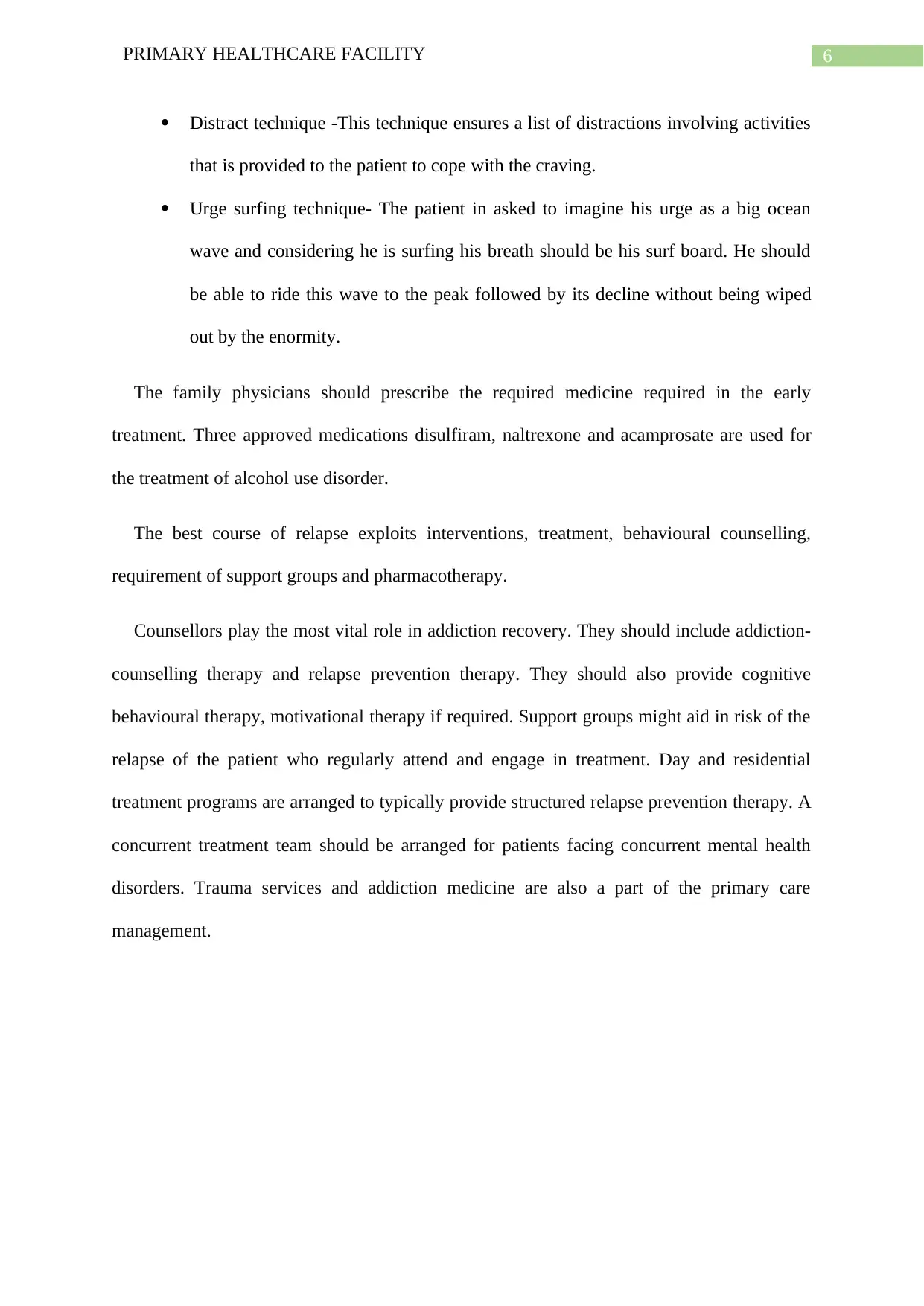
6PRIMARY HEALTHCARE FACILITY
Distract technique -This technique ensures a list of distractions involving activities
that is provided to the patient to cope with the craving.
Urge surfing technique- The patient in asked to imagine his urge as a big ocean
wave and considering he is surfing his breath should be his surf board. He should
be able to ride this wave to the peak followed by its decline without being wiped
out by the enormity.
The family physicians should prescribe the required medicine required in the early
treatment. Three approved medications disulfiram, naltrexone and acamprosate are used for
the treatment of alcohol use disorder.
The best course of relapse exploits interventions, treatment, behavioural counselling,
requirement of support groups and pharmacotherapy.
Counsellors play the most vital role in addiction recovery. They should include addiction-
counselling therapy and relapse prevention therapy. They should also provide cognitive
behavioural therapy, motivational therapy if required. Support groups might aid in risk of the
relapse of the patient who regularly attend and engage in treatment. Day and residential
treatment programs are arranged to typically provide structured relapse prevention therapy. A
concurrent treatment team should be arranged for patients facing concurrent mental health
disorders. Trauma services and addiction medicine are also a part of the primary care
management.
Distract technique -This technique ensures a list of distractions involving activities
that is provided to the patient to cope with the craving.
Urge surfing technique- The patient in asked to imagine his urge as a big ocean
wave and considering he is surfing his breath should be his surf board. He should
be able to ride this wave to the peak followed by its decline without being wiped
out by the enormity.
The family physicians should prescribe the required medicine required in the early
treatment. Three approved medications disulfiram, naltrexone and acamprosate are used for
the treatment of alcohol use disorder.
The best course of relapse exploits interventions, treatment, behavioural counselling,
requirement of support groups and pharmacotherapy.
Counsellors play the most vital role in addiction recovery. They should include addiction-
counselling therapy and relapse prevention therapy. They should also provide cognitive
behavioural therapy, motivational therapy if required. Support groups might aid in risk of the
relapse of the patient who regularly attend and engage in treatment. Day and residential
treatment programs are arranged to typically provide structured relapse prevention therapy. A
concurrent treatment team should be arranged for patients facing concurrent mental health
disorders. Trauma services and addiction medicine are also a part of the primary care
management.
Paraphrase This Document
Need a fresh take? Get an instant paraphrase of this document with our AI Paraphraser
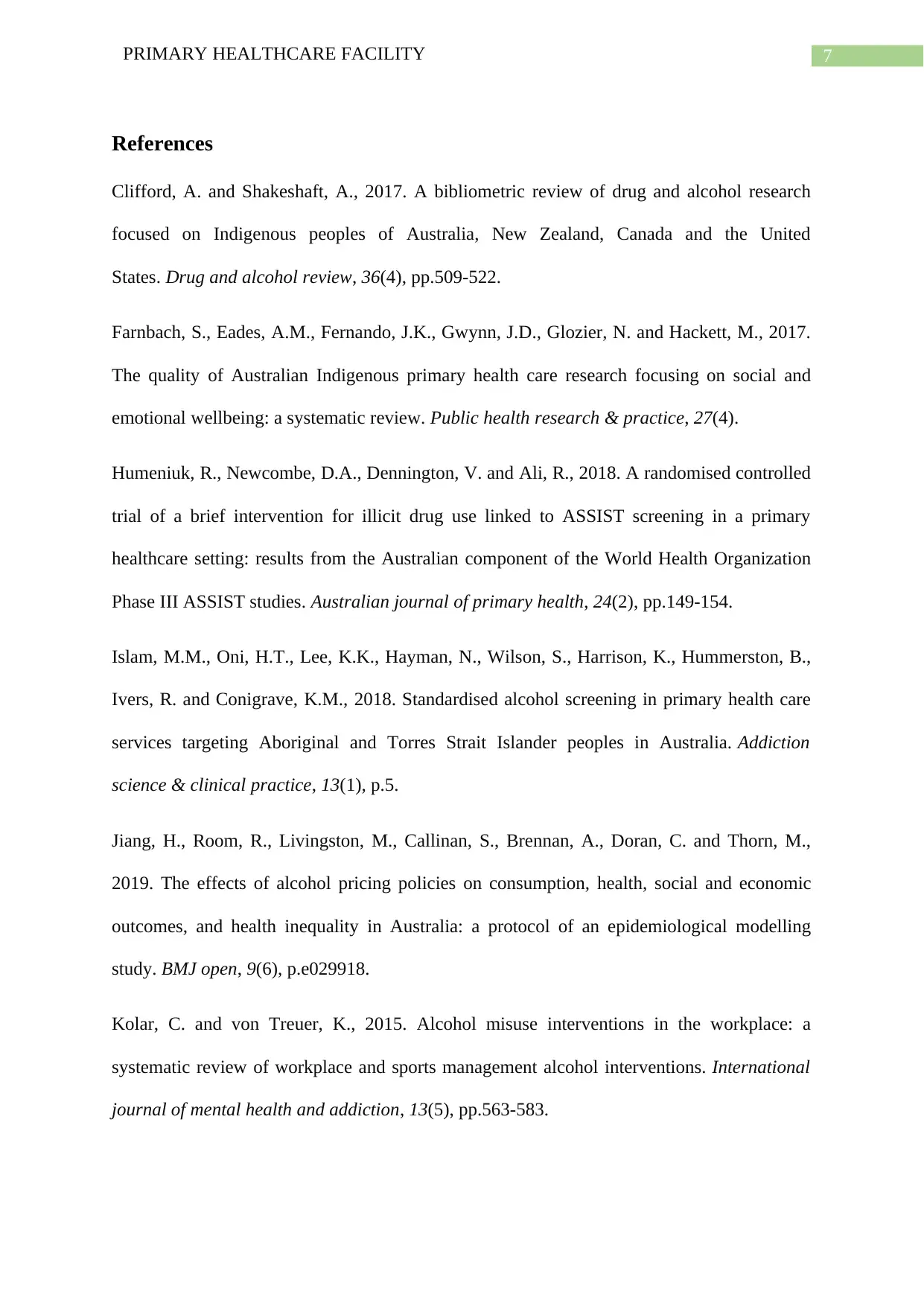
7PRIMARY HEALTHCARE FACILITY
References
Clifford, A. and Shakeshaft, A., 2017. A bibliometric review of drug and alcohol research
focused on Indigenous peoples of Australia, New Zealand, Canada and the United
States. Drug and alcohol review, 36(4), pp.509-522.
Farnbach, S., Eades, A.M., Fernando, J.K., Gwynn, J.D., Glozier, N. and Hackett, M., 2017.
The quality of Australian Indigenous primary health care research focusing on social and
emotional wellbeing: a systematic review. Public health research & practice, 27(4).
Humeniuk, R., Newcombe, D.A., Dennington, V. and Ali, R., 2018. A randomised controlled
trial of a brief intervention for illicit drug use linked to ASSIST screening in a primary
healthcare setting: results from the Australian component of the World Health Organization
Phase III ASSIST studies. Australian journal of primary health, 24(2), pp.149-154.
Islam, M.M., Oni, H.T., Lee, K.K., Hayman, N., Wilson, S., Harrison, K., Hummerston, B.,
Ivers, R. and Conigrave, K.M., 2018. Standardised alcohol screening in primary health care
services targeting Aboriginal and Torres Strait Islander peoples in Australia. Addiction
science & clinical practice, 13(1), p.5.
Jiang, H., Room, R., Livingston, M., Callinan, S., Brennan, A., Doran, C. and Thorn, M.,
2019. The effects of alcohol pricing policies on consumption, health, social and economic
outcomes, and health inequality in Australia: a protocol of an epidemiological modelling
study. BMJ open, 9(6), p.e029918.
Kolar, C. and von Treuer, K., 2015. Alcohol misuse interventions in the workplace: a
systematic review of workplace and sports management alcohol interventions. International
journal of mental health and addiction, 13(5), pp.563-583.
References
Clifford, A. and Shakeshaft, A., 2017. A bibliometric review of drug and alcohol research
focused on Indigenous peoples of Australia, New Zealand, Canada and the United
States. Drug and alcohol review, 36(4), pp.509-522.
Farnbach, S., Eades, A.M., Fernando, J.K., Gwynn, J.D., Glozier, N. and Hackett, M., 2017.
The quality of Australian Indigenous primary health care research focusing on social and
emotional wellbeing: a systematic review. Public health research & practice, 27(4).
Humeniuk, R., Newcombe, D.A., Dennington, V. and Ali, R., 2018. A randomised controlled
trial of a brief intervention for illicit drug use linked to ASSIST screening in a primary
healthcare setting: results from the Australian component of the World Health Organization
Phase III ASSIST studies. Australian journal of primary health, 24(2), pp.149-154.
Islam, M.M., Oni, H.T., Lee, K.K., Hayman, N., Wilson, S., Harrison, K., Hummerston, B.,
Ivers, R. and Conigrave, K.M., 2018. Standardised alcohol screening in primary health care
services targeting Aboriginal and Torres Strait Islander peoples in Australia. Addiction
science & clinical practice, 13(1), p.5.
Jiang, H., Room, R., Livingston, M., Callinan, S., Brennan, A., Doran, C. and Thorn, M.,
2019. The effects of alcohol pricing policies on consumption, health, social and economic
outcomes, and health inequality in Australia: a protocol of an epidemiological modelling
study. BMJ open, 9(6), p.e029918.
Kolar, C. and von Treuer, K., 2015. Alcohol misuse interventions in the workplace: a
systematic review of workplace and sports management alcohol interventions. International
journal of mental health and addiction, 13(5), pp.563-583.
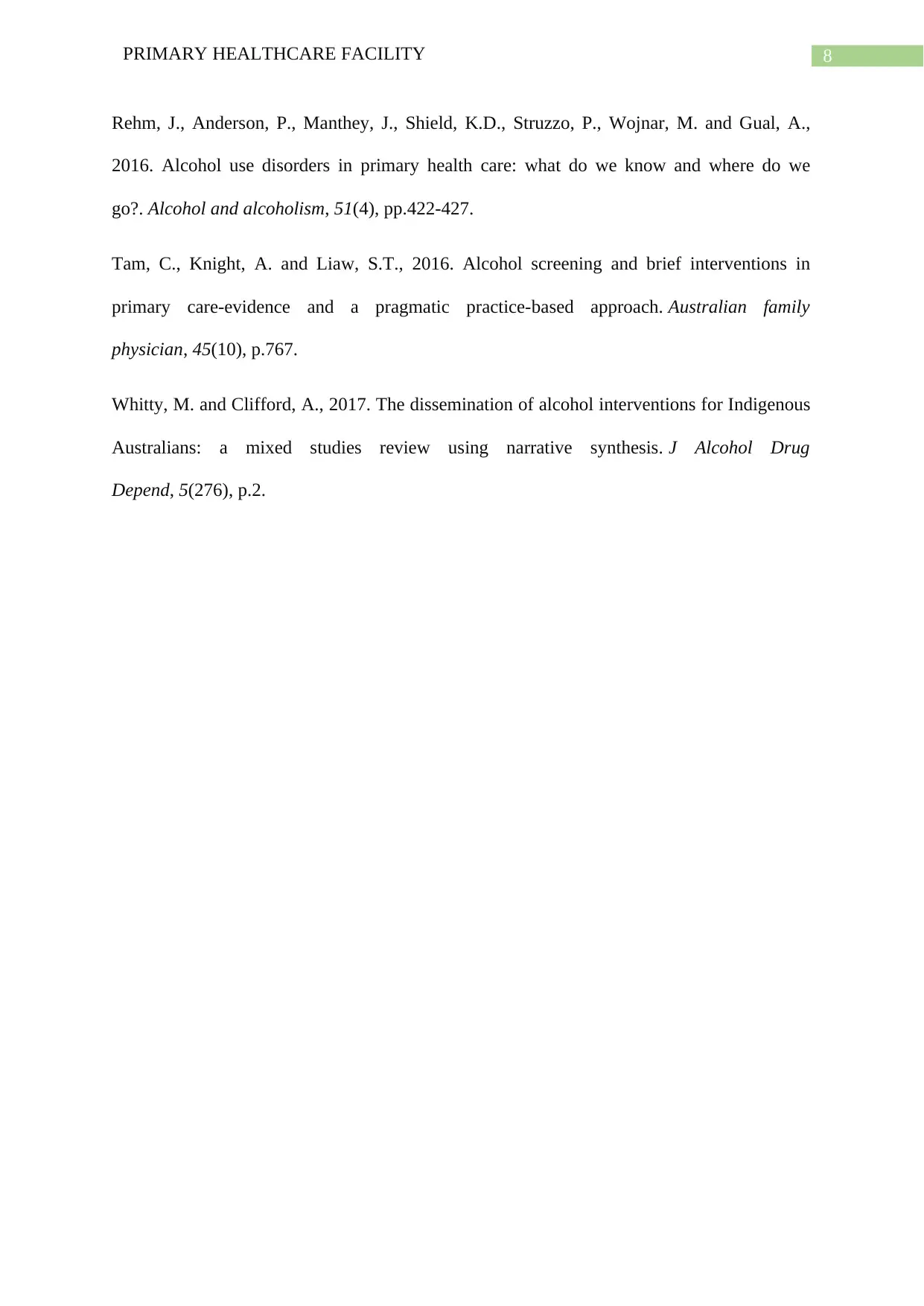
8PRIMARY HEALTHCARE FACILITY
Rehm, J., Anderson, P., Manthey, J., Shield, K.D., Struzzo, P., Wojnar, M. and Gual, A.,
2016. Alcohol use disorders in primary health care: what do we know and where do we
go?. Alcohol and alcoholism, 51(4), pp.422-427.
Tam, C., Knight, A. and Liaw, S.T., 2016. Alcohol screening and brief interventions in
primary care-evidence and a pragmatic practice-based approach. Australian family
physician, 45(10), p.767.
Whitty, M. and Clifford, A., 2017. The dissemination of alcohol interventions for Indigenous
Australians: a mixed studies review using narrative synthesis. J Alcohol Drug
Depend, 5(276), p.2.
Rehm, J., Anderson, P., Manthey, J., Shield, K.D., Struzzo, P., Wojnar, M. and Gual, A.,
2016. Alcohol use disorders in primary health care: what do we know and where do we
go?. Alcohol and alcoholism, 51(4), pp.422-427.
Tam, C., Knight, A. and Liaw, S.T., 2016. Alcohol screening and brief interventions in
primary care-evidence and a pragmatic practice-based approach. Australian family
physician, 45(10), p.767.
Whitty, M. and Clifford, A., 2017. The dissemination of alcohol interventions for Indigenous
Australians: a mixed studies review using narrative synthesis. J Alcohol Drug
Depend, 5(276), p.2.
⊘ This is a preview!⊘
Do you want full access?
Subscribe today to unlock all pages.

Trusted by 1+ million students worldwide
1 out of 9
Related Documents
Your All-in-One AI-Powered Toolkit for Academic Success.
+13062052269
info@desklib.com
Available 24*7 on WhatsApp / Email
![[object Object]](/_next/static/media/star-bottom.7253800d.svg)
Unlock your academic potential
Copyright © 2020–2025 A2Z Services. All Rights Reserved. Developed and managed by ZUCOL.





